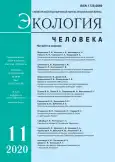Anthropometric characteristics of 8-14 years old children in three Russian cities
- 作者: Gritsinskaya V.L.1, Novikova V.P.1, Gladkaya V.S.2
-
隶属关系:
- Saint Petersburg State Pediatric Medical University
- Katanov Khakass State University
- 期: 卷 27, 编号 11 (2020)
- 页面: 38-45
- 栏目: Articles
- URL: https://journals.rcsi.science/1728-0869/article/view/52801
- DOI: https://doi.org/10.33396/1728-0869-2020-11-38-45
- ID: 52801
如何引用文章
全文:
详细
作者简介
V. Gritsinskaya
Saint Petersburg State Pediatric Medical University
Email: tryfive@mail.ru
октор медицинских наук, ведущий научный сотрудник лаборатории медико-социальных проблем в педиатрии; профессор кафедры клинической медицины и гериатрии Санкт-Петербургского медикосоциального института Saint Petersburg
V. Novikova
Saint Petersburg State Pediatric Medical UniversitySaint Petersburg
V. Gladkaya
Katanov Khakass State UniversityAbakan
参考
- Вершубская Г. Г., Козлов А. И. Физическое развитие детей дошкольного возраста Ханты-Мансийского АО по антропометрическим показателям // Новые исследования. 2019. № 2 (58). С. 37-45.
- Гаврюшин М. Ю., Березин И. И., Сазонова О. В. Антропометрические особенности физического развития школьников современного мегаполиса // Казанский медицинский журнал. 2016. № 4. С. 629-633.
- Година Е. З., Хомякова И. А., Задорожная Л. В. Особенности ростовых процессов у городского и сельского населения севера Европейской части России // Археология, этнография и антропология Евразии. 2017. Т. 45, № 1. С. 146-156.
- Гречкина Л. И., Карандашева В. О. Сравнительная характеристика физического развития детей и подростков - уроженцев первого и второго поколения европеоидов Магаданской области // Гигиена и санитария. 2017. № 96 (2). С. 171-176.
- Ефимова Н. В., Мыльникова И. В. Особенности физического развития детей Ямало-Ненецкого автономного округа // Вопросы школьной и университетской медицины и здоровья. 2018. № 3. С. 34-39.
- Койносов П. Г. Современные аспекты физического развития детей ХМАО - Югры // Научный медицинский вестник Югры. 2019. № 3 (21). С. 47-52.
- Лучанинова В. Н., Цветкова М. М., Веремчук Л. В., Крукович Е. В., Мостовая И. Д. Состояние здоровья детей и подростков и факторы, влияющие на его формирование // Гигиена и санитария. 2017. № 6. С. 561-568.
- Макарова Л. В., Лукьянец Г. Н., Параничева Т. М., Лезжова Г. Н., Орлов К. В., Тюрина Е. В., Шибалова М. С. Физическое развитие московских школьников 15-16 лет // Новые исследования. 2018. № 3-4 (56). С. 22-30.
- Максимова Т. М., Лушкина Н. П. Физическое развитие детей России: определение путей обобщающей оценки и выявления проблемных ситуаций в росте и развитии подрастающего поколения // Проблемы социальной гигиены, здравоохранения и истории медицины. 2013. № 4. С. 3-7.
- Мельник В. А., Козакевич Н. В. Влияние комплекса социально-биологических факторов на морфофункциональные показатели физического развития и половое созревание городских школьников // Курский научно-практический вестник «Человек и его здоровье». 2014. № 2. С. 56-60.
- Мыльникова И. В., Ефимова Н. В., Ткачук Е. А. Особенности физического развития городских и сельских школьников Иркутской области // Гигиена и санитария. 2018. № 97 (10). С. 957-961.
- Нифонтова О. Л., Конькова К. С. Физическое развитие учащихся среднего школьного возраста, проживающих на территории Ханты-Мансийского автономного округа - Югры // Экология человека. 2018. № 10. С. 24-31.
- Петрова П. Г. Эколого-физиологические аспекты адаптации человека к условиям Севера // Вестник Северо-Восточного федерального университета им. М. К. Аммосова. Серия: Медицинские науки. 2019. № 2 (15). С. 29-38.
- Поляков В. К., Новикова Е. П., Болотова Н. В. Физическое развитие школьников Саратова // Вопросы практической педиатрии. 2018. Т. 13, № 1. С. 7-11.
- Салдан И. П., Филиппова С. П., Жукова О. В., Швед О. И., Пашков А. П., Поцелуев Н. Ю., Шульц К. В., Нагорняк А. С. Современные тенденции в изменениях показателей физического развития детей и подростков (обзорная статья) // Бюллетень медицинской науки. 2019. № 1 (13). С. 14-20.
- Салдан И. П., Пашков А. П., Жукова О. В. Сравнительный анализ физического развития школьников 7-10 лет в городской и сельской местности // Гигиена и санитария. 2019. Т. 98, № 3. С. 308-313.
- Belisheva N. K., Martynova A. A., Pryanichnikov S. V. Age-dependent heart rate variability in preschool children living under the conditions of the European Arctic region // Human Physiology. 2016. Vol. 42 (2). P. 156-168.
- Brune M., Hochberg Z. Secular trends in new childhood epidemics: insights from evolutionary medicine // BMC Medicine. 2013. Vol. 11. P. 226.
- Devis-Devis J., Lizandra J., Valencia-Peris A., Pérez-Gimeno E., GardaMassà X., Peirà-Velert C. Longitudinal changes in physical activity, sedentary behavior and body mass index in adolescence: Migrations towards different weight cluster // Plos One. 2017. Vol. 12 (6). P. e0179502.
- Freedman D. S., Lawman H. G., Skinner A. C., McGuire L. C., Allison D. B., Ogden C. L. Validity of the WHO cutoffs for biologically implausible values of weight, height, and BMI in children and adolescents in NHANES from 1999 through 2012 // The American Journal of Clinical Nutrition. 2015. Vol. 102 (5). P. 1000-1006.
- Freedman D. S., Lawman H. G., Pan L., Skinner A. C., Allison D. B., McGuire L. C., Blanck H. M. The prevalence and validity of high, biologically implausible values of weight, height, and BMI among 8.8 million children // Obesity (Silver Spring, Md.). 2016, Vol. 24 (5). P. 1 132-1139.
- Jerrett M., McConnell R., Wolch J., Chang R., Lam C., Dunton G. et al. Traffic-related air pollution and obesity formation in children: a longitudinal, multilevel analysis // Environmental Health. 2014. Vol. 13. P. 49
- Khasnutdinova S. L., Grjibovski A. M. Urban-rural and gender differences in the prevalence of overweight and obesity among adolescents in northwest Russia // European Journal of Public Health. 2010. Vol. 20 (S1). P. 165.
- Orden A. B., Apezteguia M. C. Weight and height centiles of Argentinian children and adolescents: a comparison with WHO and national growth references // Annals of Human Biology. 2016. Vol. 43 (1). P. 9-17.
- Vondrova D., Kapsdorfer D., Argalasova L., Hirosova K., Sevcikova L. The impact of selected environmental, behavioral and psychosocial factors on schoolchildren’s somatic and mental health // Reviews on Environmental Health. 2017. Vol. 32 (1-2). P. 189-192.
补充文件







